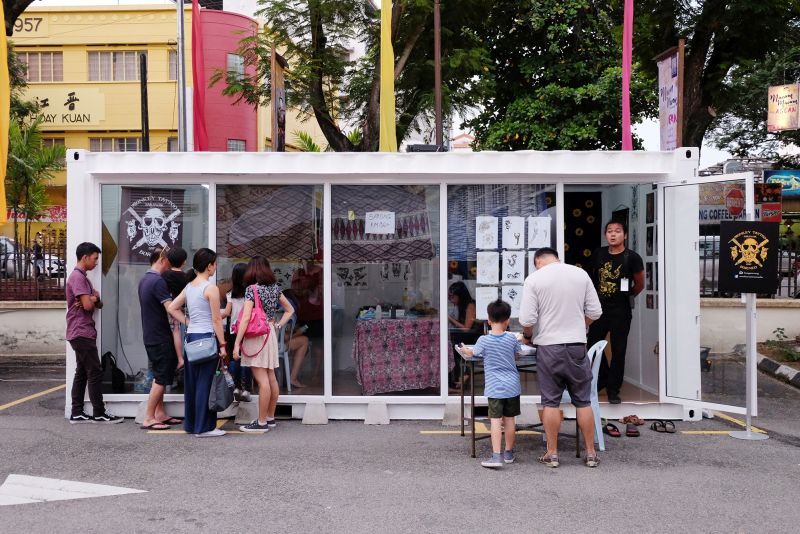GEORGE TOWN, Aug 8 — More than a century ago, getting a tattoo was a rite of passage for boys in Sarawak.
Carbon was scraped from bottoms of pots and mixed with sugarcane juice to make sooty, black ink while sewing needles were used to tattoo motifs onto the skin.
The Ibans would tattoo the bunga terung, a circular shape like a flower, on the top of the chest near the shoulders of teenage boys.
“It is like a rite of passage to adulthood for boys and due to how the tattoos were applied, some may fall sick because of it. That’s why, it is also a test of strength as the stronger ones will survive and emerge as men,” said Sarawakian tattoo artist Jeremy Lo.
He said during that period, only those with the bunga terung tattoos on the shoulders were allowed to leave the village to hunt as they are considered strong and tough enough to face any danger outside the village.
“It was also believed that if the men went out and got killed outside the village, they will go to another dimension. They have to cross a river and if the giant spirit guarding the river does not see the tattoos on their front shoulders, the giant spirit will shake the log and make those trying to cross over, fall into the river,” he said.
However, the significance of different tattoo designs and motifs on different body parts differ from tribe to tribe, the tattoo artists and which part of the river they are from.
“There are tribes like the Kayan, Kenyah and Ulu in which only women can have tattoos while the men in the tribes do not have tattoos at all,” he said.
Naturally, with modernisation, the practice of traditional tattoos among most of the tribes in Sarawak slowly died.
But in the past two decades, the tribal art is making a comeback through a growing number of young tattoo artists in the state.
“For a period of time, tribal-themed tattoos were seen as outdated and something only grandfathers would have so the younger generation only went for Western artistic tattoos,” Lo said.
That was until about 20 years ago... budding tattoo artists like Lo started showing an interest in these “outdated” and “old” designs of the past.
“In Sarawak, everywhere you turn, you will see our tribal art in carvings, on walls, furniture, decorative items and in drawings, murals, accessories and fabric,” he said.
A lot of the tribal motifs are centred around Nature with tendrils and curls that twine and loop to represent the forest, the trees and animals such as scorpions, snakes and crocodiles.
“Borneo tattoo designs are based on what we see around us, nature and the art and carvings of our ancestors in the longhouses, in the handicraft and in the fabric,” he said.
The 34-year-old, who insisted he was born “to do tattoo”, has been involved in body art since the age of 14 and after finishing school at 18, he started working in tattoo studios, first in Kuching, and after that, in Italy, the United States, Canada, Switzerland, England and Holland.
Today, Lo has his own private studio — Monkey Tattoo Studio — in Kuching but spends a majority of his time working in the Antiek Tattoo Studio in Amsterdam.
“I travel between Kuching and Amsterdam a lot and in between, I travel to events like this one,” he said.
That’s not all, Lo also organises an annual tattoo convention that he started back in 2011. “It is the biggest tattoo convention in Borneo and famous tattoo artists from all over the world will be there so like how you see a lot of laksa stalls at the event here, at the convention, you will see rows of tattoo artists from many other countries of different expertise and specialties,” he said.
Lo wanted to continue to promote the beauty and significance of Borneo tribal tattoos, a practice that was deeply entrenched in many tribes in Sarawak.
“We should be proud of our culture and our art and while some here in West Malaysia may feel tattoos are something too wild, it is a common culture in Sarawak because almost everyone there has one and it is no big deal,” he said.

In keeping with tradition and culture, Lo also offers the hand tapping way of tattooing body art.
“Of course, using the machine is faster and more efficient but some people like the novelty of hand tapping so we will use this method for smaller tattoos but definitely not bigger ones because it takes too long to do,” he said.
Hand tapping involves using a needle tied to a stick, with the artist manually drawing the design using the needle dot by dot. In comparison, modern methods involve the use of a machine, shaped like a small glue gun, where the needles are dipped in ink and then moved rapidly over the skin.
“If you ask me, hand tapping is less painful because it is done slowly while the machine does it rapidly which is more painful,” Lo said.
The Monkey Tattoo Studio was one of the vendors at George Town Festival’s Macam-Macam Asean event last weekend. Lo and his team set up a small glass booth and gave tattoos to walk-in customers during the two-day event.
To make an appointment with Monkey Tattoo Studio, email [email protected]. For more George Town Festival events this year, go to georgetownfestival.com.
















.JPG)
.JPG)
.JPG)





